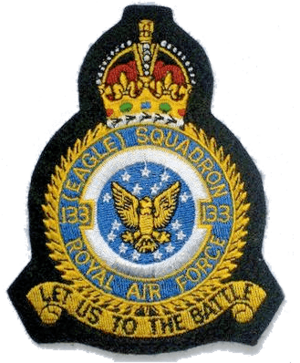No. 133 Squadron RAF facts for kids
Quick facts for kids No. 133 (Eagle) Squadron RAF |
|
|---|---|

Official badge of No. 133 squadron RAF
|
|
| Active | 1 March 1918 - 4 July 1918 1 August 1941 – 29 September 1942 |
| Country | |
| Allegiance | |
| Branch | |
| Nickname(s) | Eagle |
| Motto(s) | Let us to the battle |
| Insignia | |
| Squadron Badge heraldry | On a hurt a semée of mullets argent, an eagle displayed Or |
| Squadron Codes | MD (July 1941 - September 1942) |
No. 133 Squadron RAF was a special group of pilots during World War II. It was one of the famous Eagle Squadrons. These squadrons were made up of American volunteers. They joined the Royal Air Force (RAF) to fight alongside Britain before the United States officially entered the war.
Contents
History of the Eagle Squadron
Early Days: World War I
No. 133 Squadron first started in 1918. This was during the First World War. It was formed at RAF Ternhill in England. The squadron was a training unit. This means it helped pilots learn to fly large Handley Page O/400 bombers. They also flew Royal Aircraft Factory F.E.2 planes for training. The squadron was expected to move to France. However, it was disbanded on July 4, 1918. This happened as the war was ending. There were plans to restart it as a bomber or fighter squadron. But these plans were stopped.
Reforming for World War II
The squadron was reformed in July 1941. This was at RAF Coltishall. It became the third of the Eagle Squadrons. These squadrons were unique. They allowed American pilots to join the fight. The squadron first flew Hawker Hurricane IIB fighter planes.
In August, they moved to RAF Duxford. By October, they were at RAF Eglinton in Northern Ireland. Here, they received new planes. These were Supermarine Spitfire IIAs. The squadron then moved back to southern England. They spent time at places like RAF Biggin Hill. They flew fighter missions over France. These missions were called "fighter sweeps." The squadron continued these missions until September 1942.
Joining the US Air Force
In September 1942, the squadron changed. It was transferred to the USAAF. It became the 336th Fighter Squadron. This squadron was part of the 4th Fighter Group. This transfer was planned for all three Eagle Squadrons. It was a way for the American pilots to join their own country's air force.
The Morlaix Mission
On September 26, 1942, the squadron had a tough mission. They were escorting planes to Morlaix in France. Strong winds slowed them down. They mistook Brest for the British coast. This led to a difficult situation. They lost 11 out of 12 of their new Spitfire Mk IXs. Four pilots died during this mission. Six pilots were captured by the enemy. One pilot managed to escape capture. The squadron was transferred to the USAAF just three days later. This transfer was already planned. It was not because of this difficult mission.
Spitfire Crash in Ireland
In November 1941, the squadron was based in Northern Ireland. One of their pilots had an emergency. His name was Pilot Officer Roland "Bud" Wolfe. He was from Nebraska, USA. His plane crashed in the Republic of Ireland. At that time, the Republic of Ireland was neutral. This meant they did not take sides in the war. Because of this, Wolfe was interned. This means he was held by the Irish government.
The Crash and Internment
Wolfe was on patrol near the Inishowen peninsula. Suddenly, his Spitfire's engine got too hot. It started to lose power and altitude. He could not land safely. So, Wolfe decided to bail out of his plane. He landed safely in County Donegal. His Spitfire crashed in a heather-covered area. This area was called Moneydarragh, Gleneely.
After being arrested, Wolfe was sent to Curragh Camp. This camp was where Allied military pilots were held. The Irish government kept them there during the war. Wolfe stayed at the camp for two years. After that, he was able to return to active service. He became a fighter pilot again. By then, he and his squadron had officially joined the United States Army Air Forces.
Finding the Plane
On June 28, 2011, Wolfe's Spitfire was found. A team led by Johnny McNee recovered it. He is an aviation historian. The recovery was filmed for a documentary. The BBC made this film.
Aircraft Operated
No. 133 Squadron flew several types of aircraft:
- 1918 - Royal Aircraft Factory FE.2b
- 1941 - Hawker Hurricane IIB
- 1941 - Supermarine Spitfire IIB
- 1942 - Supermarine Spitfire VA and VB
- 1942 - Supermarine Spitfire IX
In Fiction
The squadron has even appeared in popular culture. In a 2005 episode of Doctor Who, called "The Empty Child", a character named Jack Harkness pretends to be a volunteer in the squadron. This happens in the year 1941 in the story.

